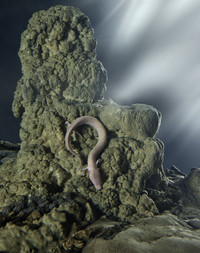The olm

The olm (scientific name Proteus anguinus) is endemic to the Dinaric Karst and the only vertebrate in Europe that lives solely in the subterranean world. Its size of 25 to 30 centimetres makes it the largest such animal in the world. The tailed amphibian belongs to the ancient family of Proteidae and is a truly precious living gem and the symbol of Slovenian natural heritage. In Slovenia, the olm is a species which is protected by law and is included in the list of rare and endangered species since 1982.
An olm can live for up to 120 years. So what is the secret to its eternal youth? First, it has great regenerative capacity, being able to replace a lost limb with a new one. And an olm can survive for up to 10 years without food. Its skin lacks any protective pigmentation, the blood showing through it making the animal a very pale pink in colour. People have often wondered whether the olm might in fact be a mythical creature, as it reminded them of a baby dragon.
The enthusiasm of scientists and the general public over this inhabitant of the Slovenian underground has continued since the discovery. But scientists are still looking for answers to many questions relating to the mysterious animal, which you can see in the Vivarium of Postojna Cave.
Due to the olm and other rare inhabitants of the caves, Postojna Cave is one of the cradles of speleobiology as a scientific discipline.
